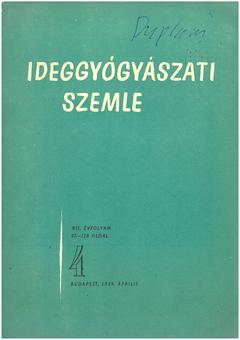The eLitMed.hu medical portal uses computer cookies for convenient operation. Detailed information can be found in the Cookie-policy.
Clinical Neuroscience - 1959;12(04)
Content
[Data on the cerebral hemisphere and lobes sclerosis]
[It can be concluded that the extensive cortical damage that is the hallmark of hemispheric atrophies and lobar scleroses is, according to the literature and our own case studies, the result of an anoxic-vascular disturbance, which is particularly predisposed to occur as a consequence of a disturbance of the flow through relatively large pial arterial trunks or arterial border zones. This is associated with convulsions in the majority of cases, but convulsions must be accompanied by some other factor perhaps more pathogenetically important than convulsions ; respiratory disturbances, stagnant anoxia, fever, hypoglycaemia, immunobiological processes. ]
[A case of pubertal psychosis ]
[Authors have taken different paths, emphasising the dominance of different characteristics in relation to the pubertal period. It is generally accepted that this age is characterised by a breakdown of the previous relative somatic and psychic equilibrium, which, together with the heightened susceptibility to stimuli from the outside world, which is also observed at this age, may be the basis for a number of dangers, including undesirable, possibly pathological, personality development. A particular interpretation of this aspect is given by Ruckert, who says that "in this age, ... everyone has before his eyes the image of what he should be, not as an abstract formula of a categorical imperative, but as a plastic image, an entelechy of the ideal constitution of his own soul..."]
[Diffuse CSF invasion of oligodendroglioma ]
[In our oligodendroglioma case, the histopathological examination revealed a ",total metastasis" of the tu. liquor pathways. The connective tissue elements are actively involved in the process of expansion in the subarachnoid space and show excitatory phenomena which we assume to be related to the blastomatous stimulus acting on them. The term "tumorous meningitis" is not uninteresting to designate the picture. The fact that this phenomenon occurs only exceptionally in oligodendroglioma cases could be explained by the fact that tu does not always succeed in overcoming the resistance of the meninges. Diffuse subarachnoid expansion is likely to occur only in conditions where the tu. reaches the brain surface extensively and acts on the meninges over a large surface area. ]
[A case of congenital word blindness ]
[In summary, we believe that congenital word blindness is not a single pathology, but rather a syndrome, in which in many cases there may indeed be an anatomical abnormality, but which, as in aphasia, never causes the loss of a specific isolated function, but which, by disrupting the dynamic unity of the nervous functions, is the main symptom of a general disorder. It is therefore plausible to assume a milder degree of mental retardation, with symptoms that are more dominant than dominant in literacy, since the literacy mechanism is the result of a complex and highly complex synthesising and analysing activity, the fragility of which can be easily assumed from the complexity of the reflex processes that are layered on top of each other. ]
[Electroclinical study with temporal lobectomy in Ammon's horn sclerosis epileptics]
[Seven patients with temporal lobe epilepsy in whom biopsy histology showed Ammon's horn sclerosis were subjected to electroclinical observations. The clinical features were high seizure activity during sleep, frequency of vegetative seizure phenomena and automatisms, personality abnormalities without intellectual impairment, intense mediobasal (garati) and hippocampal spasmodic activity. Temporal lobectomy provided the best results in the areas of EEG, seizure freedom and personality changes. Authors raise the possibility of an epileptogenic role of Ammon's horn sclerosis. ]
[Report]
[The author reports on the meeting of the French-speaking Society of Neurosurgery held on 2-3 December 1958.]
1.
Clinical Neuroscience
[Headache registry in Szeged: Experiences regarding to migraine patients]2.
Clinical Neuroscience
[The new target population of stroke awareness campaign: Kindergarten students ]3.
Clinical Neuroscience
Is there any difference in mortality rates of atrial fibrillation detected before or after ischemic stroke?4.
Clinical Neuroscience
Factors influencing the level of stigma in Parkinson’s disease in western Turkey5.
Clinical Neuroscience
[The effects of demographic and clinical factors on the severity of poststroke aphasia]1.
2.
Clinical Oncology
[Pancreatic cancer: ESMO Clinical Practice Guideline for diagnosis, treatment and follow-up]3.
Clinical Oncology
[Pharmacovigilance landscape – Lessons from the past and opportunities for future]4.
5.



